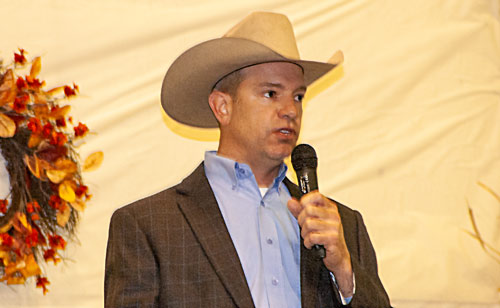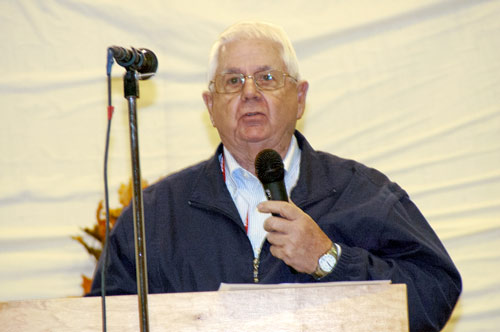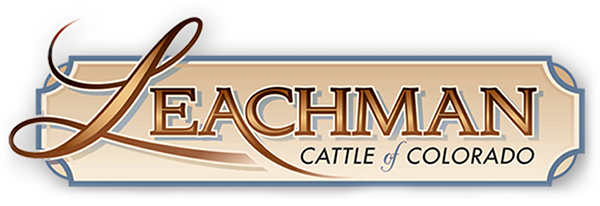Claiming a Piece of Pie
Panelists discuss views on adding value.
MITCHELL, Neb. (Nov. 20, 2019) — The value-added concept is not new to the beef industry. For years, value-added beef products that command premium prices, based on quality or specialized production practices, have been jockeying for position in the marketplace. Marketing of fed cattle has changed significantly over the last couple of decades, with a dramatic increase in the percentage of cattle sold through a grid-based marketing system designed to reward carcass merit. However, members of the cow-calf production segment of the beef industry have struggled to capture what many of their number consider to be a fair share of the added value.
 |
“At Certified Angus Beef, we think about how to make a bigger pie,” said Paul Dykstra, a beef cattle specialist with Certified Angus Beef, explaining that the goal is to provide more of a product that consumers want and are willing to pay more to have.[Photos by Troy Smith] |
During the 26th Range Beef Cow Symposium hosted Nov. 18-20 in Mitchell, Neb., an audience composed primarily of cow-calf producers heard one of their own share his views on capturing added value. Joining Britton Blair of Sturgis, S.D., in a panel presentation were cattle feeder Gary Darnall, of Harrisburg, Neb., and Paul Dykstra, a beef cattle specialist with Certified Angus Beef LLC.
Dykstra spoke first, noting how the returns to the beef industry have been compared to a pie from which only a small slice goes to cow-calf producers. Some of them fear the pie is shrinking. And many of them are working hard to reduce inputs, so the pie is less costly to make.
“At Certified Angus Beef, we think about how to make a bigger pie,” said Dykstra, explaining that the goal is to provide more of a product that consumers want and are willing to pay more to have.
Dykstra said the percentage of high-quality Choice and Prime beef has increased from just more than 50% of the fed slaughter mix in 2006 to 83% in 2018. The supply is greater, but demand remains robust, meaning consumers are willing to pay up for product that delivers the eating satisfaction they want. Recognizing that, packers offer grid-marketing opportunities for fed-cattle sellers to be paid premiums for animals that produce superior quality and meat yield.
Dykstra acknowledged that producers selling cattle through traditional marketing channels can find it difficult to claim a portion of the added value that their animals may represent. He suggested that producers consider programs like AngusLinkSM, which can help them differentiate their cattle on the basis of how they have been managed and their genetic potential to perform and meet expectations for the high-quality beef market.
Cattle feeder Gary Darnall reminded the audience that cow-calf producers have the advantage of greater marketing flexibility, including the options of selling at a sale barn, by video auction or at private treaty. They can choose to sell calves at weaning, after a backgrounding period or as yearlings off grass.
 |
Cattle feeder Gary Darnall reminded the audience that cow-calf producers have the advantage of greater marketing flexibility, including the options of selling at a sale barn, by video auction or at private treaty. |
“They can also choose to add value by retaining ownership through the feedlot,” added Darnall. “That’s how you really find out what kind of genetics you have — and you get paid accordingly, through premiums and discounts. You get a report card on your genetics that can help you plan the future of your breeding program.”
Darnall admitted that the disadvantage of retaining ownership until harvest is added risk. He suggested custom cattle feeders can help potential retained-ownership customers by calculating break-even projections, provide advice or direct assistance with financing and offer information about risk management.
Final panel speaker Britton Blair explained how his family’s cow-calf and seedstock operation embraced retained ownership and grid-marketing of fed cattle. He agreed that many ranchers shy away from retained ownership because they are leery of the risk. They may feel they are not in a financial position to place calves in a custom feedlot, or their banker may not support that decision. Some producers may have tried it once or twice and were disappointed with the outcome.
“Retaining ownership may not be the right thing to do every year,” stated Blair, referencing the all-time high calf prices of 2014. When selling calves will net record profits, it may not be the best time to try retained ownership. In other years, it is worth consideration.
“In a year of a down calf market, I’d suggest running some breakevens and giving it consideration,” Blair added. “It’s an easier decision to make if you know that your genetics will produce added value when the cattle are sold on a grid that rewards carcass merit.”
Listen to this presentation, view the PowerPoint and read the proceedings accompanying this presentation in the Newsroom at www.rangebeefcow.com.
Editor’s Note: This summary was written under contract or by staff of the Angus Media, which retains the copyright. To request to reprint this article, contact Shauna Rose Hermel, editor, at 816-383-5270. PowerPoints are posted with permission of the presenter and may not be reproduced in whole or in part without the express permission of the presenter. Angus Media claims copyright to this website as presented. We welcome educational venues and cattlemen to link to this site as a service to their audience.
Angus Media's coverage of the event is made possible through collaboration with the event committee and via sponsorship of Leachman Cattle of Colorado. For questions about this site, or to notify us of broken links, click here. Look for additional coverage in the Angus Journal, the Angus Beef Bulletin, the Angus Journal Daily, and the Angus Beef Bulletin EXTRA.



